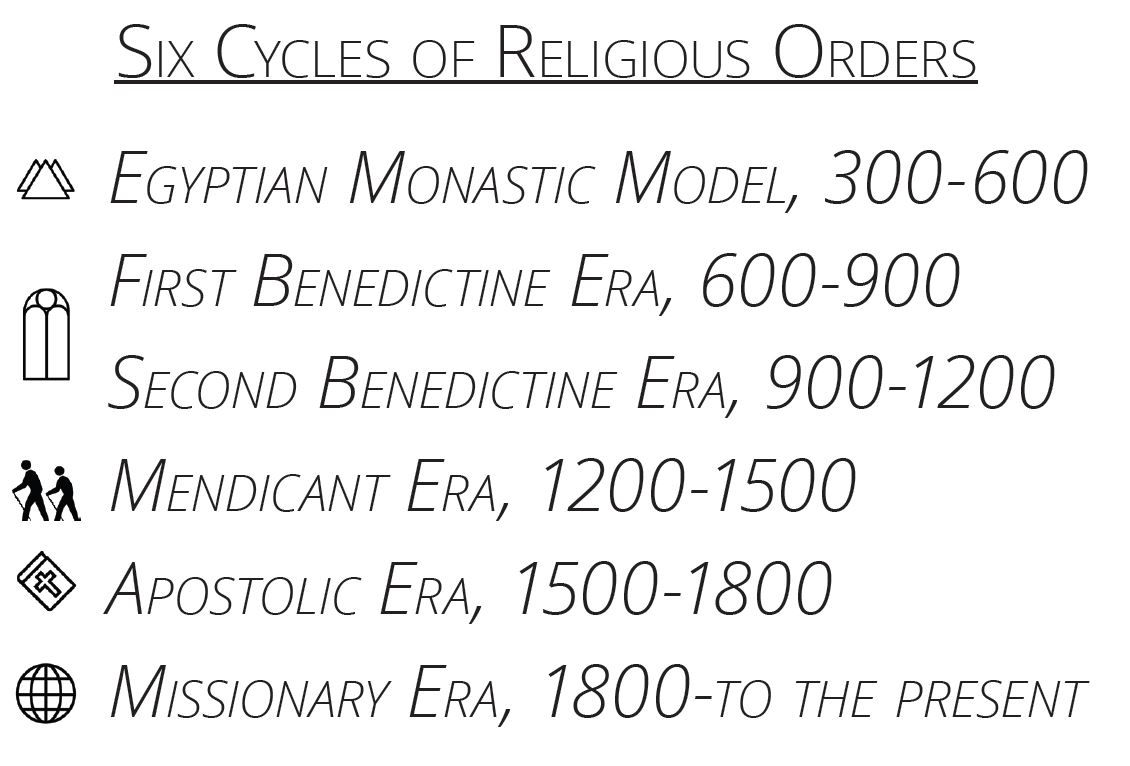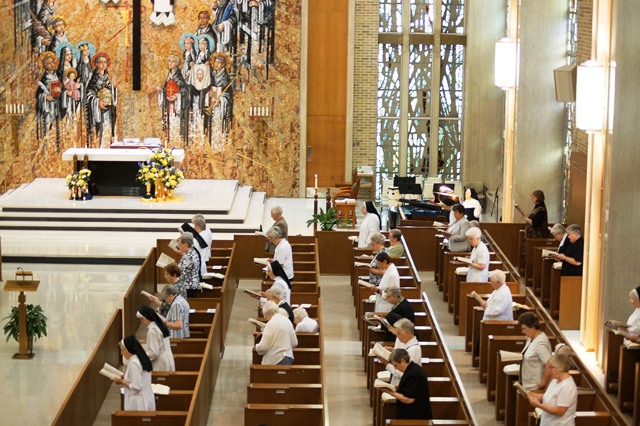This article by Sister Susan Karina Dickey, OP, first appeared in the Fall 2017 JUST Words under the title Rehabilitating Dominican Religious Life: An Historical Perspective.
Something new
One of the memorable things about St. Dominic was his willingness to try something new while borrowing and adapting from the past. For example, the idea of preachers other than bishops was an innovation. We cannot know if Dominic saw himself as an innovator, but 800 years later we frame the emergence of wandering mendicant preachers as an evolutionary breakthrough.
The mendicants were not the first to shape a new way. Church historian Raymond Hostie proposed a cyclic pattern in the emergence and eventually decline of religious communities. Others built on his 1972 book, Vie et Mort des Ordres Religieux (Life and Death of Religious Orders).[*] They identify six cycles:

Decline & renewal
Even before the desert fathers and mothers, small numbers of men and women, prompted by the Holy Spirit, banded together to form intentional communities. In every age the Holy Spirit bestows gifts on those called to embody a radically intense life of Christian discipleship suited to the times. The Order of St. Benedict, for example, established schools and engaged in several commercial activities thus filling a vacuum arising from the fall of the Roman Empire. Over time, their success led to an unwholesome exercise of privilege and power. Outside forces, including the Viking invasions of northern Europe, also contributed to decline, but the Benedictine charism of prayer and work was renewed through the Cluniac reforms.
Charismatic renewal
The fact that Benedictines, Dominicans, Franciscans, and others still exist is evidence of the lasting value of their respective charisms. The dominant form of religious life in one age does not disappear, but adapts to new conditions. The pattern is one of birth, growth, and a formalization of structures, followed by a period of flourishing. At about the 200-year mark, according to Hostie, some institutes decline and eventually disband. Sometimes external forces, such as the English Reformation or the French Revolution, brought an abrupt end. Other institutes devolved more slowly.
Still others adapted to changing conditions and continued to gift the Church and society with their charisms. Women and men of the Vincentian Family continue to prioritize service to the poor. The Ursulines still pursue the education of women. The Jesuits dominate Catholic higher education (not bad for a group that was suppressed for close to forty years beginning in 1773).
Springfield Dominicans & change
The Springfield Dominicans were founded 144 years ago, and like other societies of apostolic sisters, we are bumping up against the 200-year milestone. We are in good company. The Sisters of Mercy, the Missionary Sisters of the Sacred Heart, and the Congregation of St. Joseph, among others, experience numerical diminishment and ponder how to continue to embody their charisms with integrity. The challenges are apparent not only in our congregation in Peru and North America, but, with some exceptions, for institutes around the globe.
To meditate on the unfolding mystery of religious life is an invitation to join ourselves more closely to the spirit of St. Dominic and the early Dominicans. There were no guarantees of success or longevity for Dominic among the Albigensians; or for Henri Lacordaire, who re-founded the Order of Preachers in post-Revolutionary France, or for the 18th and 19th century North American foundresses of Dominican congregations like our own.
New life ahead?
Notice how the cycles of religious life echo the Paschal Mystery. Jesus incarnates the Divine, he grows and flourishes. He suffered persecution and died, yet rose, transformed, into new life. Sister Illia Delio, OSF, says it well: “The fact is, every aspect of life has moments of death and resurrection. We are dying all along the way. But in a participatory universe, every death is the beginning of new life; every end is a new arrival.”[†]
The concept of rehabilitation may be helpful when we look to the future of religious life. To rehabilitate means to make something livable again. Consider architecture as a metaphor. The Abraham Lincoln Home in Springfield, Ill., is a restoration. That is, the house is made to look as it did in when the Lincoln family occupied it. Rehabilitation, or “rehab” is to honor the historical integrity of a building, but make it livable with modern features needed for the way we live today. Dominic built on the foundation of monastic life and transformed it into something new: mendicant preaching. We are the heirs of Dominic, the pioneer sisters from Kentucky, and hundreds of Springfield Dominicans who preceded us. The foundation is firm. What is God calling us to build next?
Sister Susan Karina Dickey, OP, is director of mission integration for St. Dominic Health Services and a historian.
[*] In describing the cycles, I am indebted to the work of Diarmuid O’Murchu in Religious Life in the 21st Century: The Prospect of Refounding. New York: Orbis Books, 2016. Kindle edition.
[†] Illia Delio, OSF, “An Interview with Illia Delio, OSF, Seeing Christianity as a Religion of Evolution and the Implications for Religious Life,” LCWR Occasional Papers, Summer 2012.


